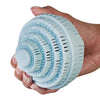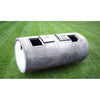A drip septic system releases small amounts or “drips” of wastewater at regular intervals, maximizing the treatment of sewage and minimizing the risk of untreated wastewater quickly flowing through the soil. Drip septic systems are often used on steep slopes, forested areas and other places where trenches are difficult to install. They are also used in places such as golf courses and resorts that only operate during the warmer months of the year. Drip septic systems are often used in conjunction with pretreatment systems such as aerobic septic systems and sand filters.
There are three main components to a drip septic system:
- The septic tank
- The lift tank, which contains a pump and filter. The pump and lift station distribute the wastewater evenly through the tubing and the soil.
- The dispersal unit, which consists of a supply and return line.
It contains perforated tubing, which carries the wastewater to the soil. The perforations or orifices are called “drip emitters” and are placed at intervals of 12-24 inches, allowing the wastewater to seep into the soil. The tubing is connected to a feed line on one end and a return line on the other, which allows the system to be automatically back flushed on a regular basis.
There is also a control panel, which monitors pressure changes, temperature, pump performance and daily wastewater flow. The control panels can sometimes help alert homeowners and professionals to potential problems.
How to maintain your drip septic system
It is extremely important to clean the septic tank periodically to remove accumulated sludge and scum. This is important in any system with a septic tank, but even more critical with a drip septic system. Drip septic systems contain several filters that can get plugged with solids, and the drip tubing itself has small holes which can get plugged.
Other key components which require maintenance are:
- The filters need to be cleaned manually or changed once a year
- The holes in the drip tubing can get plugged with solids. The system back flushes the tubing automatically on a regular basis to help prevent this problem. However, if they still get plugged in spite of this, they may need to be manually back-flushed.
- The tubing itself may need to be replaced.
Because the water lines in a drip distribution system are placed at a shallow depth, they may freeze during the winter. As a result, thermocouples (which measure soil temperature) are placed next to the lines to warn the homeowner when a freeze is imminent.
As you may know from researching this topic, failing Septic Tanks are a major financial and environmental problem in this country. Expensive septic repairs can often run from $5,000 to $20,000 or more and a large number of systems are failing throughout the country. For news stories related to failing Septic Tanks and tightening regulations you can go to: http://www.laundry-alternative.com/failingseptic.htm
You also can’t sell your home if it has a failing system. For more information on how to properly maintain your Septic Tank, go to: http://www.laundry-alternative.com/septic_system_maintenance.htm













